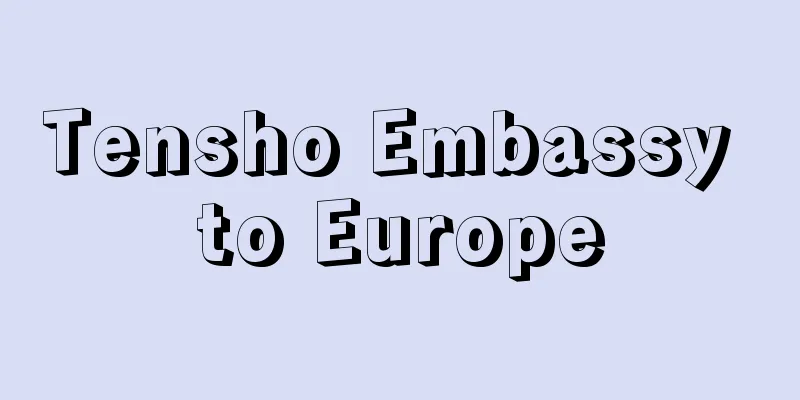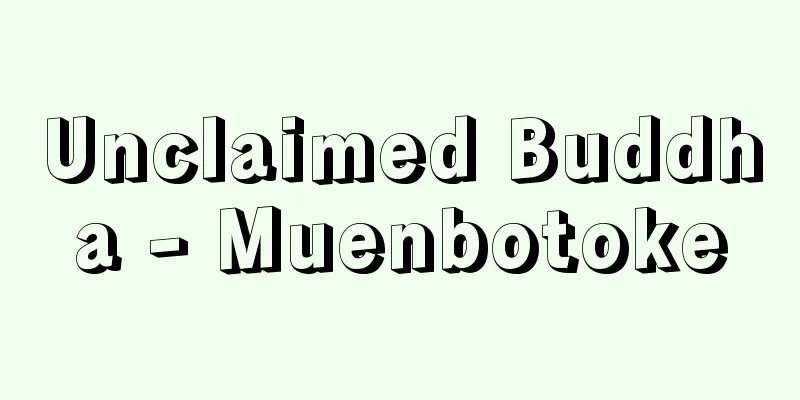Tensho Embassy to Europe

|
During the Tensho era, Ito Mancio and three other young envoys were dispatched to Southern Europe by the Jesuits as representatives of the Christian feudal lords of Kyushu. They are also known as the "Tensho Young Envoys" or the "Tensho Ken-Eu Young Envoys." Valignano, a Jesuit missionary to Japan who came to Japan in the latter years of Oda Nobunaga's reign, planned to send young Japanese men to Europe as envoys for Christian feudal lords just before leaving Nagasaki in February 1582 (New Year's Day, Tensho 10). One of the purposes was to have the Japanese see and hear how magnificent and magnificent the Christian world in Europe was, and to have them speak directly to their compatriots upon their return, thereby achieving success in missionary work. Another was to introduce the Japanese to the Pope and other royalty and nobles in Europe, to move their hearts, deepen their understanding of the missionary work in Japan, and ask for their support. The selection of the envoys was hasty, and among the students of Arima Seminario on the Shimabara Peninsula, Mancio Ito, a distant relative (son of the younger sister's younger sister's husband's younger sister) was selected as the representative of Otomo Sorin, Miguel Chijiwa, a relative of Harunobu Arima (Shigetaka) and Sumitada Omura, was selected as the representative, and Juliao Nakaura and Martino Hara were selected as deputy envoys. The group reached Goa in 1583, but Valignano had to stay there, so the Portuguese Diogo de Mesquita, who was fluent in Japanese, took charge of the envoys. They arrived in Lisbon in August 1584. At that time, King Philip II of Spain was also the King of Portugal, so they went to Madrid to receive an audience, and with his help they crossed the Mediterranean and headed for Italy. After receiving a warm welcome in the Grand Duchy of Tuscany, the envoys were received by Pope Gregory XIII on March 23, 1585, with the highest possible treatment among imperial kings, and were also promised assistance by the next Pope, Sisto V, who bestowed them with Roman citizenship certificates. They then continued their journey through northern Italy, passing through Spain and Portugal on their way home. They were reunited with Valignano in India, but when they arrived in Macau, they received news from Japan that Toyotomi Hideyoshi had issued an edict to expel missionaries, and the envoys were allowed to enter the country as envoys of the Viceroy of India. In July 1590 (June 18th year of Tensho), the group returned to Nagasaki, and in March of the following year (leap New Year in the lunar calendar), they had an audience with Hideyoshi at Jurakudai. The four envoys, including the principal and deputy envoys, joined the Society of Jesus, but later Miguel Chijiwa renounced his faith, and the other three became priests. However, all of them died of illness or were martyred, and they were not able to carry out their activities as Valignano had hoped. However, their achievements in making Japan and the Japanese known to the Christian world in Europe were great. [Takeichi Matsuda] "Okamoto Yoshitomo, translated and annotated, 'The Record of the Mission of the Three Lords of Kyushu to Europe' (1942, Toyodo)" ▽ "The Historiographical Institute of the University of Tokyo, edited and published, 'Great Japanese Historical Materials, Volume 11, Supplementary Volume, Historical Materials Related to the Tensho Embassy to Europe' (1959)" ▽ "De Sande, The Record of the Tensho Embassy to Europe, translated by Izumi Hisanosuke et al. (1969, Yushodo Publishing)" ▽ "Matsuda Takekazu, 'The Historical Tale of the Tensho Embassy to Europe' (1977, Kodansha)" [References] |Source: Shogakukan Encyclopedia Nipponica About Encyclopedia Nipponica Information | Legend |
|
天正年間に九州のキリシタン大名の名代として、イエズス会の企画によって南ヨーロッパに派遣された伊東マンショら4人の少年使節。「天正少年使節」「天正遣欧少年使節」ともいわれる。 織田信長の晩年に来日したイエズス会日本巡察師バリニャーノは、1582年2月(天正10年正月)に長崎を離れる直前に、日本人の若者をキリシタン大名の使節としてヨーロッパに派遣することを企てた。その目的の一は、かの地のキリスト教界が、いかに華麗で偉大であるかを日本人に見聞させ、帰国後、その同胞に直接語らせることによって布教上の成果を期したこと、他は、ヨーロッパにおいてローマ法王をはじめ王侯貴族に日本人を紹介することによって、彼らの心を動かし、日本での布教事業に理解を深めてもらい、援助を請うことにあった。使節の人選は急いだこともあって、島原半島の有馬(ありま)セミナリオの在学生のなかから、大友宗麟(そうりん)の名代としては、その遠縁(妹の娘の夫の妹の子)である伊東マンショ、有馬晴信(はるのぶ)(鎮貴(しげたか))と大村純忠(すみただ)の名代としては両人の親族である千々石(ちぢわ)ミゲルとし、中浦ジュリアン、原マルチノ両人を副使に任じた。一行は1583年ゴアに達したが、バリニャーノはそこにとどまらねばならなくなり、日本語に通じたポルトガル人ディオゴ・デ・メスキータが使節の指導にあたった。1584年8月リスボンに到着。当時、ポルトガル国王はスペイン国王フェリペ2世が兼ねていたので、マドリードに赴いて謁見を賜り、その援助によって地中海を渡り、イタリアに向かった。トスカナ大公国で大歓迎を受けたのち、1585年3月23日、使節らは法王グレゴリウス13世から、帝王の間において最高の待遇をもって引見され、次の法王シスト5世からも援助を約束されたり、ローマの市民権証書を授けられたりしたのち、北イタリアの旅を続け、スペイン、ポルトガルを経て帰国の途についた。インドにおいてバリニャーノと再会したが、マカオに着いたところ、日本からは、豊臣(とよとみ)秀吉が宣教師追放令を発したとの報に接し、一行はインド副王の使節の資格で入国を許可された。 1590年7月(天正18年6月)一行は長崎に帰り、翌年3月(旧暦閏(うるう)正月)、聚楽第(じゅらくだい)において秀吉に謁した。正副4使節はイエズス会に入ったが、のち千々石ミゲルは棄教し、他の3名は司祭になったが、いずれも病死、殉教死を遂げ、当初バリニャーノが期待したようには活動できなかった。しかし、ヨーロッパ・キリスト教世界に日本と日本人を知らしめた功績は大きい。 [松田毅一] 『岡本良知訳・注『フロイス・九州三侯遣欧使節記』(1942・東洋堂)』▽『東京大学史料編纂所編・刊『大日本史料 11編別巻 天正遣欧使節関係史料』(1959)』▽『泉井久之助他訳『デ・サンデ天正遣欧使節記』(1969・雄松堂出版)』▽『松田毅一著『史譚・天正遣欧使節』(1977・講談社)』 [参照項目] |出典 小学館 日本大百科全書(ニッポニカ)日本大百科全書(ニッポニカ)について 情報 | 凡例 |
<<: Electric lighting cultivation
Recommend
Error control system
When transmitting digital data over a communicatio...
administrative county
…In England, although there have been changes in ...
Glass Bead Game
…In 1930, he published “Nartzis and Goldmund”. As...
Kuchitori - Kuchitori
〘Noun〙① The role of pulling the horse's sashin...
Fujiwara no Akihira - Fujiwara no Akihira
Year of death: 2nd year of the reign, October 18th...
Chuvash - Chubashigo
A Turkic dialect of the Altaic language family. A...
common tansy
…European Artemisia gigu is considered to be a va...
Wilkins - Maurice Hugh Frederick Wilkins
British biophysicist. Born in New Zealand. After ...
Magistrate of the Supreme Court - Ossobugyonin
…Eventually, in 1264 (Bun'ei 1), an instituti...
Almohad
…1130-1269. In Spanish, it is called Almohade. It...
Weinstein, L.
...the phenomenon in which bacteria resistant to ...
Hook - Koroku
Also called double hooks. A technique of oriental ...
Iikiroku (Record of a Foreign Land) (English: Yi-yu-lu; I-yü-lu)
A travelogue of Siberia written in both Chinese an...
External object - Gaikitaisho
...The origin of this approach was the position o...
Pendulum scale - Pendulum scale
A general term for scales that use a pendulum in t...









